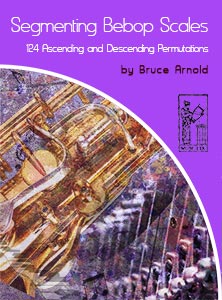
This book by Bruce Arnold “Segmenting Bebop Scales 124 Ascending and Descending Permutations,” is an in-depth analysis on the application of segmenting Bebop scales into 124 ascending and descending permutations. The meticulous examination delves into the intricate patterns derived from these segmented scales, shedding light on their musical significance and structural variations especially as it relates to jazz improvisation.
By scrutinizing the ascending and descending permutations of Bebop scales, a comprehensive understanding of their melodic properties is achieved. This study contributes to the scholarly discourse on music theory and improvisation techniques, offering valuable insights into the creative possibilities unlocked by segmenting Bebop scales.
The research in this book elucidates the intricate nuances of Bebop scales and their permutations, providing a rich resource for musicians and scholars alike to explore the complexities of this musical domain especially in how it relates to the jazz sound and octatonic scales.
Working with the “Segmenting Bebop Scales 124 Ascending and Descending Permutations” course is an important part to creating the Bebop sound used in jazz improvisation. As you learned in the “124 Bebop Scales” course, Bebop scales are 8 note scales, these are usually common seven notes scales where an added note is tacked on which creates a 3 note chromatic passage at some point within the scale.
To get the Bebop effect musicians tend to gravitate towards not only segmenting Bebop scales but also gravitating towards the section of the Bebop scale that contains the added note. By doing this you create the characteristic jazz sound often used in the Bebop era.
In this course Bruce Arnold takes you through some of the common Bebop scales and segments them both ascending and descending. There are also a host of other octatonic scales found in the course, 124 Bebop Scales to be exact, that could be used as Bebop scales but also could be used as an eight note scale to compose or improvise with in jazz improvisation or other idioms.
Segmenting Bebop scales is present in 12 keys for all 124 Bebop Scales. This is a vast resource for both developing a jazz sound but also for exploring octatonic scales. I’d recommend starting with the more common Bebop scales which are listed on page 2 of the course. I would learn to segment two or three Bebop scales before moving on the “Segmenting Bebop Scales with Approach Notes.“ or exploring some of the other octatonic scales found in the course.
You will quickly find that not only do these segmented Bebop scales give you a strong “Jazz Sound” but they also helps you understanding time and groove. In the traditional way of using these scales you need to put the chord tones found in the Bebop scale on the beat. This takes a while especially if you have never thought of playing scales this way.
The main part of this course is found in the 248 pages that segment the Bebop scales ascending and then again another 248 pages that segment the Bebop scales descending. Being able to segment a Bebop scale means you know the scale in a much more profound way and this technique is often found in jazz improvisation and is key to creating the jazz sound so often used in the Bebop style.
This course will teach you to start the Bebop scale in 4 different places which will prepare you for the next course “Segmenting Bebop Scales with Approach Notes.“
Table of Contents:
Segmenting Bebop Scales
Common Bebop Scales
Course Breakdown
124 Bebop Scales
Bebop Scales and Chords They Work Over
How to Practice Bebop Scales
Segmenting Bebop Scales Examples
Conclusion
List of Contents for Segmenting Bebop Scale Course:
Jam Tracks V1 (MP3’s of 10 chord types in all 12 keys)
ISBN: 978-1-59489-289-9
Bruce Arnold Music Education Genealogy Chart
You might enjoy checking out the “Music Education Genealogy Chart” located on my artist’s site. You will clearly see the historic progression of pedagogy that is the basis for Muse Eek Publishing Products. Great musicians throughout history have been studying the ideas presented by Muse-eek.com which derives its content from a a lineage that stretches back to Scarlatti!


